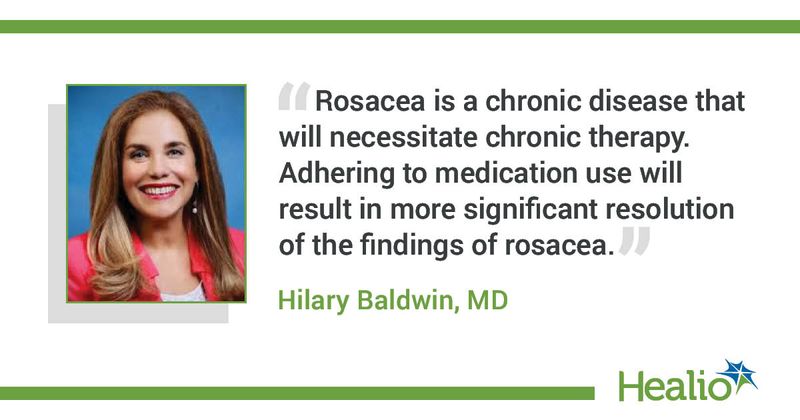Q&A: Involve patients in therapeutic decisions to best improve rosacea treatment adherence
Click Here to Manage Email Alerts
The National Rosacea Society has designated the month of April as Rosacea Awareness Month, aiming to educate the public about this chronic inflammatory skin condition and its available treatments.
Rosacea is a disease with varying signs and symptoms that, if left untreated, can worsen over time. With more treatment options now available, physicians can personalize care and work together with their patients to find the most effective treatment.

Healio spoke with Hilary Baldwin, MD, associate professor of dermatology at Rutgers Robert Wood Johnson Medical School, to learn more about available treatment options and the importance of therapy adherence.
Healio: What rosacea treatments are currently available?
Baldwin: We have a wealth of treatment options in 2022. Choices of pharmacologic treatment are based on the patient’s particular aspects of disease.
For the background erythema of rosacea, Mirvaso (brimonidine, Galderma) and Rhofade (oxymetazoline, EPI Health LLC) do a good job of decreasing redness on a daily basis. Numerous topical medications and one oral medication are available for inflammatory lesions. Depending on severity of disease, we may use more than one topical or a topical along with an oral treatment.
Topical medications include Soolantra (ivermectin, Galderma), Zilxi (minocycline 1.5% foam, VYNE Pharmaceuticals Inc.), Finacea (azelaic acid, LEO Pharma) and Metrogel (metronidazole, Galderma). Not only are these medications effective, but side effects are uncommon and mild.
Oracea (anti-inflammatory dose doxycycline, Galderma) is the only oral medication FDA-approved for rosacea. It is effective, unlikely to cause side effects and does not cause antibiotic resistance that is associated with full-dose doxycycline. Isotretinoin, although not FDA-approved for this indication, is useful for refractory disease.
Additionally, laser and light treatments work well for treating telangiectasias and reducing the background redness of rosacea. Phymatous tissue can be removed by numerous physical modalities.
Most patients will have multiple aspects of rosacea: background erythema, telangiectasias, inflammatory lesions and ocular involvement, so combination therapy is the norm.
Healio: Why is it important for patients to adhere to these medications?
Baldwin: Rosacea is a chronic disease that will necessitate chronic therapy. Adhering to medication use will result in more significant resolution of the findings of rosacea. Additionally, it has been shown that patients who use their medications consistently and reach clear skin (as opposed to merely improved skin) may be able to stop using their medications for several months. Some will remain clear indefinitely.
Healio: How can dermatologists ensure patient buy-in for adhering to medications?
Baldwin: Adherence to medications is a challenge with any disease, particularly when it is chronic in nature. More so than with short-term fixes, medications intended to be used for the long haul need to be user-friendly. Use of the simplest regimen possible, avoiding tolerability issues, utilizing affordable products and paying attention to cosmetic elegance will improve the likelihood of regular usage.
These requirements highlight the importance of obtaining patient buy-in with the regimen from the get-go.
As clinicians, our job is to endeavor to fix all aspects of a patient’s rosacea. However, many patients are bothered by a particular finding (inflammatory lesions or erythema) and not others. Since inflammatory lesions and erythema do not respond to the same medications, combination disease will require combination therapy, complicating the regimen.
Before embarking on a therapeutic regimen, it is important to ascertain what characteristics of disease are most bothersome to the patient. Inflammatory lesions can be treated with topical or oral medications and many patients have a preference. Erythema can be treated pharmacologically or with laser or light therapy. Giving the patient a say in therapeutic options can improve adherence.
Healio: What treatment options are in the pipeline?
Baldwin: We will soon be able to prescribe benzoyl peroxide (BPO) for our rosacea patients with inflammatory disease. Historically, BPO has been shown to be effective, but tolerability issues prevented its use in those with sensitive skin. The new product, microencapsulated BPO 5%, encapsulates the BPO in a porous silica shell. Rather than placing a large bolus of BPO onto the skin, small amounts are released over time resulting in efficacy without irritation.
Healio: Some rosacea phenotypes cause negative social, emotional and psychological effects. What are your tips for managing patients’ mental health over the course of treatment?
Baldwin: It is important as clinicians to treat all aspects of a patient’s disease. Encourage patients to express the negative psychosocial impact of their disease. Referral, if appropriate, to a mental health colleague is often helpful. Reminding patients that consistent use of their therapeutic regimen will result in rapid efficacy can be helpful. Since the disease is chronic, periodic inquiries regarding ongoing emotional distress are warranted.
Healio: What else should dermatologists know about rosacea treatment adherence?
Baldwin: Studies with both topical and oral rosacea medications have indicated a difference between clear and near-clear outcomes (or better vs. well). In clinical trials, the FDA considers “treatment success” to be attaining the state of clear or near clear. But in real life, clinicians and patients know the difference between the two.
There is a sizeable difference in residual lesions and in patient quality of life. Furthermore, attaining clear has been shown to be associated with a longer remission of disease than those who stop therapy at the near clear stage. Some patients who reach clear never relapse. Overall, it behooves us to push ourselves and our patients to reach clear.
Reference:
- Rosacea Awareness Month to highlight the importance of adherence to therapy. https://www.rosacea.org/press/2022/february/rosacea-awareness-month-to-highlight-importance-of-adherance-to-therapy. Published Feb. 8, 2022. Accessed Feb. 17, 2022.
For more information:
Hilary Baldwin, MD, can be reached at hbaldwin@acnetrc.com.
